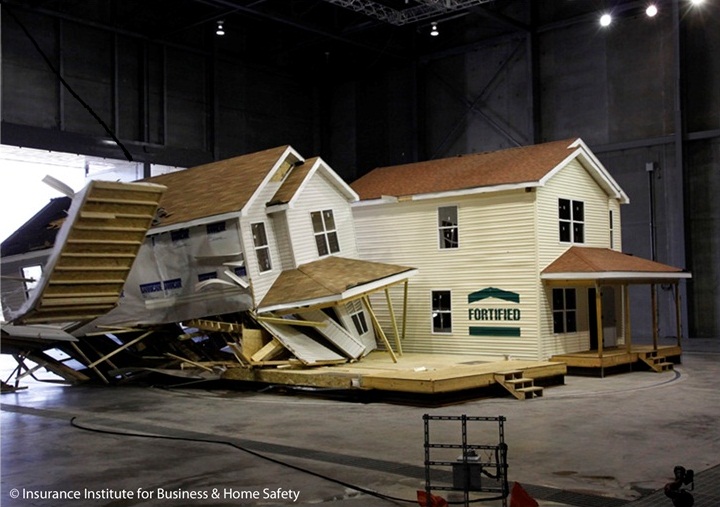4 May 2012
Building resilience as weather worsens
Posted by kramsayer

The Insurance Institute for Business & Home Safety tested two houses in 95-mph winds; the one on the right, which had only $3,000 worth of improvements, fared significantly better. (CREDIT: IBHS)
Two adjacent, brand-new houses – one was torn from its foundation by winds, the other stood strong. A mere $3,000 in building costs made the difference, including a simple wind-resistant measure: a front door that stays shut in a storm because it’s built to open outward rather than inward.
The 95-mile-per-hour winds that blasted the two homes were not in some recent hurricane, but in an experiment conducted in the world’s largest wind tunnel, Carl Hedde told an audience May 1 at the AGU Science Policy Conference in Washington, D.C. The test chamber is part of a $40-million research center the insurance industry has created in Chester County, South Carolina, to investigate ways of making structures less vulnerable to natural disasters.
“We’re taking steps to build better and safer structures,” said Hedde, senior vice president and head of risk accumulation for Munich Re in Princeton, N.J.
Munich Re is a reinsurance firm (i.e. a company that insures insurance companies) that was also one of the AGU science policy conference sponsors. Hedde, who spoke in a session about decreasing the economic toll of disasters, also serves as chairman of the board of the Insurance Institute for Business and Home Safety, the non-profit organization created by insurance companies that funds the research center and other building-safety programs. The institute’s test chamber has also subjected full-scale buildings to dousing, and jets of burning embers (which simulate wildfires). Engineers are gearing up now to pummel buildings next year with artificially produced hail storms.
Such experiments are taking place against a backdrop of increasing damage and financial losses globally from earthquakes, tsunamis, tornadoes, hurricanes, winter storms, hail, droughts, wildfires and other natural perils.
Thomas Karl, director of the National Climatic Data Center in Asheville, N.C. , who also spoke in the session, noted that in 2011, the United States experienced a record-breaking number of extreme weather events that each caused damage of a billion dollars or more. And extremes are increasing across a variety of weather types, from tornadoes, to heavy rainstorms, to warmer minimum temperatures, Karl said, citing data from several analyses, some not yet published.
Another speaker, Frank Boteler, discussed changes expected in U.S. agriculture as climate patterns shift. Those include different types and locations of crops planted and rethinking irrigation strategies. Boteler is the assistant director of the Institute of Bioenergy, Climate, and Environment of the US Department of Agriculture’s National Institute of Food and Agriculture in Washington, D.C.
Daniel Aldrich learned about natural disasters up close and personal in 2005 when Hurricane Katrina hit New Orleans and a 15-feet-deep flood inundated his home on Canal Boulevard.
Aldrich, a social scientist currently on a fellowship at the U.S. Agency for International Development in Washington, D.C., and also a speaker on the panel, has conducted research since then on the resiliency of communities struck by disasters. He has drawn upon nearly 7,000 interviews of New Orleans residents, mostly conducted by another scientist. He has also studied survivors of the 1923 and 1995 earthquakes in Japan and the 2004 Indian Ocean tsunami in India. Aldrich found that stricken communities in which people are entwined socially bounce back more readily from disasters. “Individuals who are tightly bound together are more able to collectively organize,” he said. On the other hand, “individuals who are more atomized, less connected … tend to leave or to cause problems in the recovery.” Aldrich has written a book about his findings, which will come out in August.
Besides better anticipating extreme weather and building more weather-resistant structures, communities can improve how well they fare in such shocks by strengthening their social fabric. “Our goal should be to build up social networks,” Aldrich urged.
-Peter Weiss, AGU Public Information manager


 GeoSpace is a blog on Earth and space science, managed by AGU’s Public Information staff. The blog features posts by AGU writers and guest contributors on all sorts of relevant science topics, but with a focus on new research and geo and space sciences-related stories that are currently in the news.
GeoSpace is a blog on Earth and space science, managed by AGU’s Public Information staff. The blog features posts by AGU writers and guest contributors on all sorts of relevant science topics, but with a focus on new research and geo and space sciences-related stories that are currently in the news.